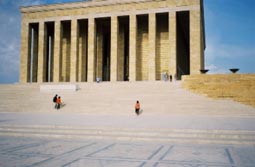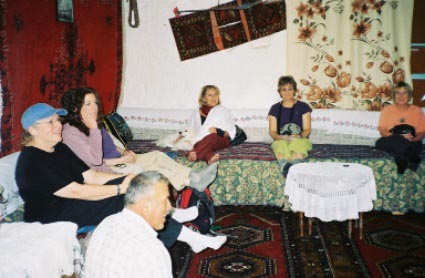

Day 13, Friday October 15, 2004
Submitted by Betty Bonham
Bettybonham@aol.com
Ephesus
13th day of unclaimed jewels of the
Mediterranean travels
 We are visiting Ephesus today, but first we stop at a lovely mosque to sit
in the courtyard and listen to Meli explain the history of Ephesus. Ephesus
began 4000 BC. It is a synthesis of the cultures and religions that have
come before each other. Meli described it as a sieve, through which elements
of each culture/religion have fallen through.
We are visiting Ephesus today, but first we stop at a lovely mosque to sit
in the courtyard and listen to Meli explain the history of Ephesus. Ephesus
began 4000 BC. It is a synthesis of the cultures and religions that have
come before each other. Meli described it as a sieve, through which elements
of each culture/religion have fallen through.
In the lovely surroundings of this mosque, Meli tells us about:
(1) The Amazons; (2) Androculeas of Macedonia and the oracle of
fish/fire/boar;
(3) the 12 Ionic cities and how the first bank of Ephesus came about;
(4)persian invasion; (5) Alexander the great and the 3rd city of Ephesus;(6)Christians and the eventual abandonment of the city to malaria in 700AD.
In the Ephesus museum, we see how the marble of the Zodiac temple was used
as a quarry for the building of St. John's basilica. Recycling predates the
20th century?
Next we visit the house of the Virgin Mary, where Pamela is told by a
British tourist that Virgin Mary is actually buried in England, where her
son, Jesus, came many times to inspect the tin mines he owned.
What is it about Pamela that attracts these strange Brits?
Finally, Ephesus, itself. What a phenomenal place. Home to 1/2 million
people. Running water and a public toilet seating 42.
In the meantime, Ramadan has started. We hear the drumming at 3:30am
reminding the faithful to make their commitment, and eat their last
meal before fasting starts. After our wonderful tour of Ephesus,
we return to our hotel in Selcuk to celebrate breaking of fast with
Hussein, our wonderful, patient driver and to drink to future
trips with Meli. Meli pours water into a plant with "may your life
flow as smoothly as this water and prosperity come to you and your
loved ones". We tearfully say goodbye and prepare for the journey
home.
MELITOUR Home Page
Next Page